Just as sure as the daylight hours grow longer in the spring, tax time is one thing you know always rolls around each year like clockwork. For many, this annual assessment is preceded by headaches and stress, but we’re here to tell you that if you approach it strategically, tax documentation can be fairly painless. Here are some best practices for Small Business Owners in preparation for tax season.
Organization is Key
Recent innovations in technological security have drastically reduced the need to submit original sales and expense receipts required for taxes in years past. Instead, the important information that must be provided annually, along with the current financial reports, can be secured and submitted with a few keystrokes and clicks of the mouse. Basically, good filing habits and proper organization will ease the way in which tax prep materials can be gathered, resulting in the swift completion of your tax returns.
Create an electronic file template to collect the information needed each year. A copy of the template can be made at the start of each year and act as a reminder to you of information that should be gathered throughout the year.
- Regular, consistent use of a computerized accounting system or app will make keeping track of financial information a relative cinch. For example, daily or weekly entries of sales and expenses, depending on the volume of transactions, along with using a chart of accounts to classify data, can eliminate the mad rush at year’s end.
- Regular backups of computer files stored off-site can be a lifesaver. Recovering information from a computer crash can be expensive and time-consuming; worse yet, it’s often not completely successful. Remember the motto: “Save early and save often” when working with sensitive information.
Perennial Documents
Some data stays the same year-to-year, or changes very little. For example, requirements often found at the top of any tax preparer’s list can be retained in a file separate from those with the variable information that fluctuates up or down each year.
- Articles of incorporation or a partnership agreement and any amendments or bylaws
- Basic identification for the company and any partners or shareholders – names, addresses, Federal and State Tax ID Numbers (TIN)
- Mortgage and other loan documents
- Beginning and ending statements for the year
- Amortization schedules provided by the lender
- Copies of any loan agreements
- Depreciation schedules
- Tax returns from previous years – they may not be needed but can be useful for reference
- Any information pertaining to owners or partners, such as contributions, loans, distributions, legal agreements, etc.
Annual Information to Prepare
Much of the annual information required for tax preparation can be easily retrieved from any current accounting program. Many have features that allow you to grant online access to ease the transfer of information. Reports such as a Balance Sheet, Income Statement, Cash Flow Statement and General Ledger can be created and saved with a few simple keystrokes. Other items can be set aside in an electronic file:
-
Monthly bank and credit card statements saved from the bank website or scanned each month
-
Inventory counts taken periodically
-
Depreciable asset purchases and disposition records
-
Petty cash reconciliation
-
Liability Insurance certificates and business licenses
-
Employee health insurance coverage
-
Payroll reports, including wages, employment taxes paid, and workers' compensation coverage
-
Mileage and vehicle use records
The philosopher Bertrand Russell said, “Organized people are just too lazy to look for things.” Following these tips to get your files organized in advance of tax season can provide you with the leeway to be a "good kind of lazy” around tax time, while others are stressing out - and it may even help you to retain your sanity for the rest of the year!
As soon as you have all the necessary files ready, contact Myrick CPA to schedule your virtual tax preparation appointment.





